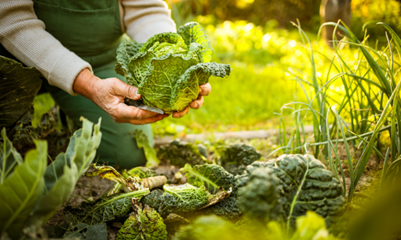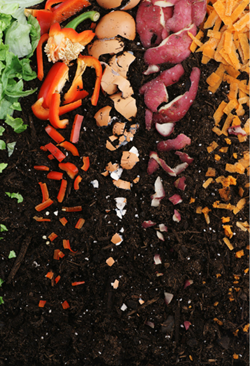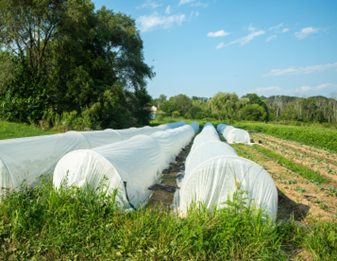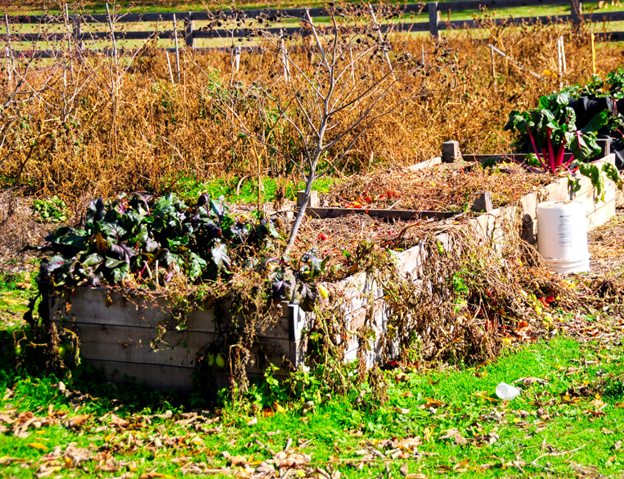Bugging out? How to keep your garden healthy while minimizing chemicals.
Guest Contributor: Cassey Anderson, CSU Horticulture Agent


Organic Gardening. The term brings up images of beatific gardeners tending gently to their crops, harvesting lightly, never leaving footprints, never sweating or stressed out. There are benefits to gardening organically, but when pests come to feed sometimes ideals can go out the window. No matter the practice you hold true in your garden, there’s a place for you in growing and producing your own food! Organic gardening can be regenerative, sustainable, environmentally friendly, but not always. Alternately, more conventional gardening practices can also be regenerative, sustainable, and environmentally friendly, but not always. If you’re getting hot under the collar, don’t fear, any gardening is good gardening in my book!

A Review of Organic Gardening, what is it?
Organic gardening is typically defined as growing foods without synthetic fertilizers, pesticides, or hormones. The goal of an organic system is to develop healthy soils, and surrounding ecosystems to better support food production. That said, there is no true definition of organic gardening at the home scale because there is no USDA certification for gardens that produce less than $5,000 in revenue annually. Now, I might feel like I put $5,000 into my home garden each year but I certainly don’t earn that!
The University of Georgia says: “Contrary to popular belief, organic gardening is neither a method of pest control, nor the avoidance of the use of all chemical pesticides.” Unfortunately, it’s a truth that even if you decide you’re using no pesticides whatsoever, that does not stop the pests from coming. This is when, the concept of IPM, or integrated pest management becomes invaluable. Integrated pest management is a strategy that focuses on pest prevention through a combination of techniques (some of which we’ll cover below). Essentially with IPM you seek you create an environment that allows your plants to thrive but inhibits the pest in establishment or growth.
IPM does determine a particular threshold of pest damage that is deemed acceptable. For example, I can tolerate cabbage looper caterpillars on my broccoli, they float off when cooked and don’t bother me, but my threshold may be lower if I’m donating or selling my produce so I may need an alternative control option to keep cabbage loopers off my broccoli. Let’s look at some common organic garden practices you can incorporate into your own backyard whether you seek to be completely organic in practice or just follow some of the principles.
Soil

Soil is very important in most gardening systems, as it provides the basic nutrients, support, and moisture for good plant development. The goal for good vegetable production is to have soils with a 3-5% soil organic matter level (SOM). This level allows enough plant available soil nitrogen to for plant growth that supplemental N requirements are low to non-existent. Higher levels of SOM can become problematic as microbes begin to take up excess N to decompose the carbon, defeating the purpose of having a sustained system. In an organic system the nitrogen comes from organic sources, as in a conventional system, but avoids the use of supplemental, synthetic fertilizers. Synthetic fertilizers feed the plant but not microbes and other critters living in our soil. To maintain SOM of 3-5% it is necessary to continue to apply organic material into the soil in some form as it does break down, get used up, or release into the atmosphere as CO2. A soil test can help you to determine how frequently you will need to reapply (it’s likely less often than you think once you hit that 5% threshold).
You can have a conventional garden with great SOM, and use occasional supplemental synthetic fertilizers, or stay organic and supply extra N requirements with organic sources such as bone meal, feather dust, soybean meal etc. The decision is up to personal preference and your plants will love you either way!
Organic systems often promote “no till” gardening. The benefits to reducing soil disturbance are many and are well documented. Each time garden soil is disturbed SOM can be lost, microbes can be exposed to air and die, and mycelial systems can be disrupted and disturbed.
Pest control
![Lacewing larvae [Image Credit: Whitney Cranshaw, Colorado State University, Bugwood.org]](https://unicorn-s3.b-cdn.net/Picture3-400x300-e2lo0.jpg)
Just because you declare you’re gardening organically this year does not mean that the pests will avoid your plants. Let’s go through some organic approaches to pest control. The following are some of the most common strategies that follow integrated pest management principles important to any garden, organic or otherwise.
Inspect – early detection is key to keep crop losses at a minimum. If a plant is diseased you may need to rogue it out before the disease can spread to other plants (generally of the same family). If you find one solitary cucumber beetle, or aphid you may be able to prevent exponential growth before they get established.
Trap crops – some crops are particularly susceptible to insect pests. You can plant a less desirable plant near your wanted crops to attract insects away. As an example, you can plant an extra tomato plant, and allow your tomato horn worms to have a feeding frenzy, thereby protecting your prize love apples. I’ve also seen this work well if you want to protect your broccoli and kale, by planting brussels sprouts.
Resistant crops – some varieties may be less toothsome to a pest or less susceptible to a disease. Many seed catalogues will give this information when you purchase them.

Row cover – when reducing populations of many insect pests it can be useful to exclude them completely. Using a tightly sealed row cover can exclude insects if placed prior to establishment. This method does not work for crops like a tomato or a cucumber that rely on pollinators to produce fruit. It is great for leafy greens, root crops etc. that do not require pollination.

Intercropping – avoid large blocks of the same variety of plant in a garden, when possible. By breaking up plants over an area you can confuse pests and reduce their populations. Without a large block of the same plants insects cannot establish as thoroughly. This is not always possible, as some plants, such as corn, require proximity to each other. You can even plant flowers in with your vegetables to encourage pollinator visitation and for beneficial insects to stick around.
Organic pesticides (they do exist, but still use caution and read the label) – when all else has failed and you still have pests coming for your produce there are organic pesticide options which include: Bt (Bacillus thuringiensis), pyrethrums, clove oil, horticultural grade vinegar, diatomaceous earth, neem and other horticultural oils and insecticidal soaps. Just because these are labeled organic however does not mean they are all safe, so be cautious when purchasing and applying. Pesticides are a product designed to eliminate a pest whether disease, insect or weed. Those that are labeled and sold at a store have been tested to be safe when used according to the label. Please avoid using home recipes or making your own pesticides as they are not labeled for that intent.

Garden cleanup – remove all plant material to reduce carryover of disease or insects from one year to the next. Some insects and diseases can overwinter in garden debris, even mulch. If your plants had disease issues (early blight on tomato, powdery mildew on bean or squash) dispose of them outside of your home compost system. It can be tempting to leave your garden alone after the first hard freeze, but don’t leave it for long as it can harbor insects and disease that can carry over to next year.
Some more reading:
https://ag.umass.edu/home-lawn-garden/fact-sheets/what-is-organic-gardening
https://newswire.caes.uga.edu/story/5975/organic-gardening.html
https://extension.missouri.edu/publications/g6220
https://extension.illinois.edu/blogs/good-growing/2022-09-30-what-no-till-garden-can-do-you
As always, reach out to your local Extension office with additional questions and for further resources. Happy Gardening!

Gardening in Colorado? Check out Grow & Give www.growandgivecolorado.org and in particular our Colorado Vegetable Guide https://growgive.extension.colostate.edu/colorado-vegetable-guide/ for more crop information on all of the above plants.
What if every gardener planted just one extra plant to share?
One small donation can have a tremendous impact. Just imagine, if every gardener planted one extra plant to share, collectively, we would have an abundant source of fresh, healthy produce available to be distributed to families experiencing food insecurity in our own communities! The free Fresh Food Connect mobile app connects you to a local hunger relief program, then manages and tracks your donations of homegrown produce throughout the season. Download the app today!